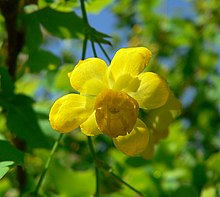| Berberis fremontii | |
|---|---|

| |
| Scientific classification | |
| Kingdom: | Plantae |
| Clade: | Tracheophytes |
| Clade: | Angiosperms |
| Clade: | Eudicots |
| Order: | Ranunculales |
| Family: | Berberidaceae |
| Genus: | Berberis |
| Species: | B. fremontii |
| Binomial name | |
| Berberis fremontii Torr. | |
| Synonyms | |
| |
Berberis fremontii is a species of barberry known by the common name Frémont's mahonia (after John C. Frémont).
Description
Berberis fremontii is an erect evergreen shrub growing up to 4.5 meters tall. The leaves are several centimeters long and are made up of several holly-leaf-shaped leaflets, each most often 1–2.6 centimeters long and edged with spiny teeth. The leaves are purplish when new, green when mature, and greenish blue when aged.
The abundant inflorescences each bear 8 to 12 bright yellow flowers, blooming in the spring. Each flower is made up of nine sepals and six petals all arranged in whorls of three. The fruit is a berry up to 1.5 centimeters wide, ranging in color from yellowish to purple to nearly black.
Taxonomy
Berberis fremontii was scientifically described and named by John Torrey. For many years it has been part of the controversy on if parts of the Berberis genus should be classified as Mahonia. Friedrich Karl Georg Fedde classified it as Mahonia fremontii in 1901. However, as of 2023 Plants of the World Online (POWO) classifies it as part of Berberis.
Names
The plant was named in honor of John C. Frémont.
Distribution and habitat
Berberis fremontii is native to mountainous regions of the US states of Arizona, Nevada, California, Colorado, New Mexico and Utah. It grows in desert grassland and pinyon-juniper woodland.
Uses
The Zuni people use the crushed berries as a purple coloring for the skin and for objects employed in ceremonies.
References
- ^ "Berberis fremontii Torr". Plants of the World Online. Royal Botanic Gardens, Kew. Retrieved 9 November 2023.
- ^ Whittemore, Alan T. (5 November 2020). "Berberis fremontii - FNA". Flora of North America. Retrieved 9 November 2023.
- Laferrière, Joseph Edward (1997). "Transfer of Specific and Infraspecific Taxa from Mahonia to Berberis (Berberidaceae)". Botanicheskii Zhurnal. 82 (9): 95–97. Retrieved 8 November 2023.
- ^ "Berberis fremontii in Flora of North America @ efloras.org". www.efloras.org.
- Stevenson, Matilda Coxe 1915 Ethnobotany of the Zuni Indians. SI-BAE Annual Report #30 (p. 88)
External links
- Calflora Database: Berberis fremontii (Fremont barberry)—formerly Mahonia fremontii.
- Jepson Manual eFlora (TJM2) treatment Berberis fremontii (Fremont barberry)—formerly Mahonia fremontii.
- USDA Plants Profile for Mahonia fremontii (Fremont barberry)
- Colorado Wildflowers Mahonia Fact Sheet
- U.C. Photos gallery of Berberis fremontii
| Taxon identifiers | |
|---|---|
| Berberis fremontii |
|
| Mahonia fremontii | |